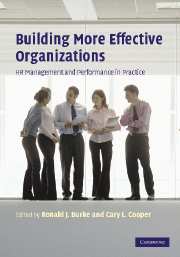Book contents
- Frontmatter
- Contents
- List of figures
- List of tables
- List of contributors
- Foreword
- Preface
- Acknowledgements
- Part I Building more effective organizations
- Part II Enhancing individual health and performance
- Part III Enhancing organizational health and performance
- 6 Maximizing the value of leadership development: key questions (and some answers)
- 7 Best practices in building more effective teams
- 8 Career development processes in organizations
- 9 Fostering organizational learning: Creating and maintaining a learning culture
- 10 Work–life balance, best practices and healthy organisations: A European perspective
- 11 Diversity management practices in leading edge firms
- Part IV Transforming organizations
- Index
11 - Diversity management practices in leading edge firms
Published online by Cambridge University Press: 05 June 2012
- Frontmatter
- Contents
- List of figures
- List of tables
- List of contributors
- Foreword
- Preface
- Acknowledgements
- Part I Building more effective organizations
- Part II Enhancing individual health and performance
- Part III Enhancing organizational health and performance
- 6 Maximizing the value of leadership development: key questions (and some answers)
- 7 Best practices in building more effective teams
- 8 Career development processes in organizations
- 9 Fostering organizational learning: Creating and maintaining a learning culture
- 10 Work–life balance, best practices and healthy organisations: A European perspective
- 11 Diversity management practices in leading edge firms
- Part IV Transforming organizations
- Index
Summary
Introduction
Diversity management is an important and popular tool to manage the various individual differences (such as sex, race, ethnicity, religion, disability, age, parental status and so on) that people bring into the workforce, so that the employer can draw on their diversity as an organisational resource, to access new markets, to enhance creativity and improve decision making and to recruit from a wider talent pool (Cox and Blake, 1991). In some contexts, such as the USA, this new diversity discourse which is focused on individual differences appears to be replacing the affirmative action discourse about the need for special treatment for disadvantaged groups such as women and racial minorities (Kirby and Harter, 2003). In the UK, the business case for diversity tends to sit alongside the fairness case of equal opportunities (Liff, 1999), as employers want to be seen as good places for women and other minority groups to work, as well as endorsing the business case for diversity. To address this challenge of competing discourses with their focus on individual and/or group level differences, diversity is increasingly being associated with policies concerned with inclusion. There are a number of excellent practitioner texts on how to implement diversity management, particularly the book by Kandola and Fullerton (1998) drawing on the ‘diversity as mosaic’ metaphor. However, there is no golden rule for guaranteed success, nor is there a single initiative that can deliver sustainable results.
- Type
- Chapter
- Information
- Building More Effective OrganizationsHR Management and Performance in Practice, pp. 252 - 278Publisher: Cambridge University PressPrint publication year: 2007
- 4
- Cited by



